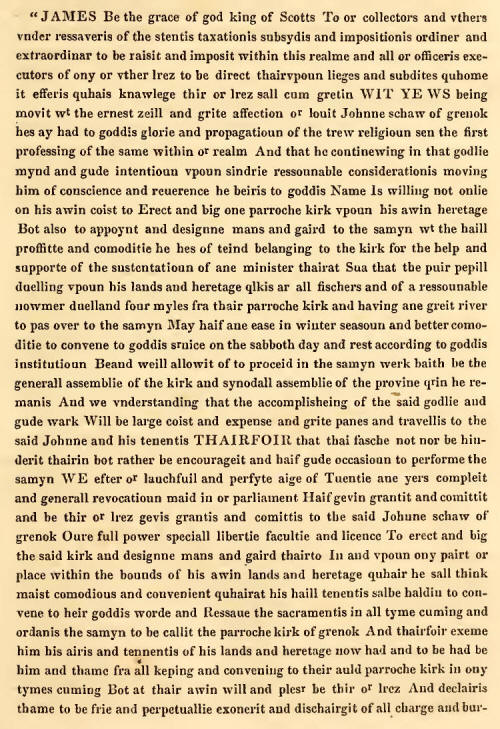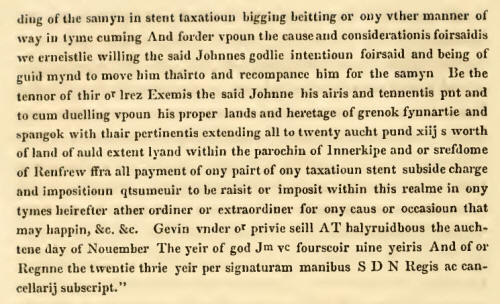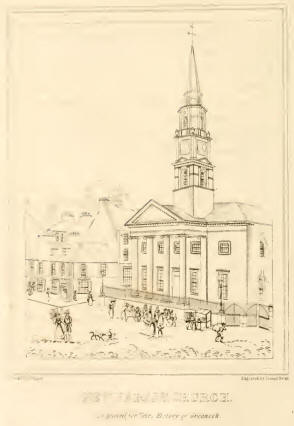|
The Town is situated on the south bank of the Clyde, and in the lower ward
of Renfrewshire, in long. 4. 45. 30. W. and lat. 33. 57. 2. W. It is distant
about twenty-two miles from Glasgow. Has in front an extensive and beautiful
bay, which was known by the name of the bay of St. Lawrence, from a small
chapel which was dedicated to that Saint, and stood on the site of that
house at the west corner of Virginia Street, belonging to the heirs of the
late Mr. Roger Stewart. In digging the foundation of this house, a number of
human hones were found, which proves that a burying ground must have been
attached to it. About 1760 the chapel was in high preservation.
A little below Kilblain stood the remains of a Catholic chapel, and the
tenant was permitted to remove the stones to enclose his garden, in doing
which, a variety of old coins were found, and more particularly the
Cruikstone dollar.
A third stood at the extremity of what is now the east boundary of the East
Parish, which must have been the principal cemetry; for when the late Mr.
King took in these grounds as a kitchen garden, many grave stones were found
sunk beneath it spade deep. What confirms the authenticity, is the fact of
this being part of the farm of Chapelton, on the estate of Greenock.
These chapels are supposed to have been swept away, amidst the general wreck
of religious houses, at the Reformation, and the inhabitants of the barony
of Greenock were obliged to travel on the Sabbath six weary miles, through
bad roads, and over dangerous rivulets, to the church of Innerkip, or as it
was anciently known as the parish of Daff. Much inconvenience having been
found from the great distance of the parish church, John Schaw of Grenok
obtained, in 1589, a charter from the King, authorizing him to build a
church, for the accommodation of the tenants and inhabitants of his lands of
Greenock, Finnart, and Spangock. The following is a copy of the royal
charter, granted by King James VI., to Sir John Schaw, for disjoining or
separating a particular portion or territory from the parish of Innerkip,
(which as being the ''Mother Church" of the district, is still known by the
appellation of the " Auld Kirk,") for the formation of the parish of
Greenock, since divided into three parishes—the West, the Middle or New, and
the East parish. The document which we allude to, is dated at Holyroodhouse,
the 18th day of November, 1589, and was subsequently ratified in the
Scottish Parliament in 1592, and is as follows:


The proprietor having obtained this charter, erected a church and manse in
1591, and also set apart a piece of ground adjoining, as a churchyard ; on
the 4th April, 1592, the Synod of Glasgow authorized the burying of the
(lead in the new kirkyard of Greenock,. In 1594 another Act of Parliament
was passed in favour of John Shaw, by which his lands of Greenock, Finnart,
and Spangock, with all their titles and ecclesiastical duties, were
disjoined from Innerkip, and erected into a distinct parsonage and vicarage,
which were assigned to the newly erected parish of Greenock. On the 16th
September, 1600, the Synod of Glasgow ordained, that the inhabitants of Over
and Nether Greenock should meet in one congregation. The parish of Greenock
continued as thus established till 1636, when there was obtained, from the
lords commissioners for the plantation of churches, a decree, whereby the
baronies of Wester and Easter Greenock, and various other lands, which had
belonged to the parish of Innerkip, with a small detached portion of the
parish of Houston, were erected into a parish to be called Greenock, and the
church formerly erected at Greenock, was ordained to be the parochial church
of which Shaw of Greenock was the patron.
The church, though finished in 1591, had not a regular pas- tor till 160,
when John Lang was appointed minister; in 1640, James Taylor; in 1679, Neil
Gillies, privately called by the parish; 1688, - Gordon, officially, who
continued till 1691, when he returned to his old charge at Inverary; in
1694, John Stirling from Inchinnan, who in 1701 was admitted Principal of
the College of Glasgow; and in 1704, Andrew Turner from Erskine, who died in
1719. In the same year he was succeeded by his son David Turner, who died in
1786. In 1786, Alan M'Aulay was appointed. Some alleged improprieties of
behaviour brought him before the presbytery; they held their meeting iii the
present Town Hall, and on that occasion the celebrated Mr. Muir, of
Hunter's-hill, (who was banished for his share in the revolutionary meetings
of the friends of the people) appeared on behalf of the church. Mr. M'Aulay
died while his case was under consideration, and was succeeded in 1792 by
Robert Steel, the present minister. In 1798, the stipend was only £96 in
money, and a glebe of six acres, worth £30 yearly. The stipend was
afterwards augmented to £111 in money, with thirty-two bolls of meal; and,
by the act of Parliament in 1801, authorizing feu grants of the glebe, for
building, at an average rent of £100 per acre, the value of the glebe has
been raised raised to £600 a year ; and the whole revenue of the minister is
about £800, with thirty-two bolls of meal, yearly, constituting it one of
the best livings in Scotland.
The west parish, which still retains the name of the old parish, comprehends
the western part of the town, and the greater part of the country district.
The patronage belongs to Sir Michael Shaw Stewart of Greenock. The church is
situated at the east end of the glebe, and close by the shore. It stands in
the midst of an extensive burying ground, and though there is nothing
remarkable in its appearance, has still a venerable aspect. It is built
nearly in the form of a cross, and has a small belfry on the west side. Here
the first bell which was in Greenock is supposed to have been placed, and
till within the last thirty years it gave a merry chime on marriage
occasions, or a mournful toll when some worthy was consigned to the dust.
This place continued till 1741 the only place of worship, and contains a
seat for Sir Michael the lord of the manor, and another for Crawford of
Cartsburn, the proprietor of Cartsdyke. There is also a farmers gallery; and
on the opposite side another for seamen, with a ship full rigged suspended
from the roof the rest is appropriated to general sitters. In wandering
through the church- yard, there is but little to attract the eye which is
not common to every burying ground, and Greenock possesses but few
illustrious dead, over whose graves we would be apt to linger with emotions
of regret. Yet here unnoticed, and scarcely known, is now "mouldering in
silent dust," Highland Mary, the object of Burns' purest and most exalted
attachment, and the theme of some of his finest effusions. Here also the
father of the illustrious James Watt reposes in peace, though not altogether
uncomemorated. And here you are reminded of that awful calamity, the
sinking of the steam boat Comet, on the 21st of October, 1825, by observing
the grave w hikh contains Sir Joseph Radcliff's servants, who perished on
that mournful occasion.
Thus as we move with solemn tread,
Above those mansions of the dead;
Time was, like us they life possest,
And time shall be when we shall
rest.
The increasing population in 1741, rendered it necessary to have more church
accommodation than the parish church afforded, and accordingly this ycar the
new parish church was established, and a minister ordained for it. This
parish is confined entirely to the town, and is known by the designation of
the Mid Parish.
At the time the first minister was ordained, there was no regular place of
worship, except a large loft at the Royal Closs,

now occupied partly with Bailie Ewing's office; and in the doss adjoining a
bell was liimg upon triangles, for the purpose of warning the people to
church. Up to this time Greenock possessed no steeple, and the only
tell-tale time could boast of, was a sun dial, placed. oil the western
corner of that house, on the north cast corner formed by the intersection of
Cross Shore and Shaw Streets, and which appears from a stone in front to
have been built in 1716, and was one of the four slated houses which
Greenock was possessed of prior to 1720. In 1753, however, the minister of
the mid parish remonstrated with the magistrates on unsafe state of the
triangles, and wished them repaired, but it was thought by the worthy
council a more economical plan to erect a "timber steeple" on town cellars
then finished, and to give the inhabitants the benefit of a clock. This was
carried into effect almost immediately, and was considered a chef d'oeuvre
in this species of architecture and well it might, for the aspiring
Greenockians had previously nothing to mark the tardiness or speed of time,
save the sun dial, and Rip Van Winkle's clock, "the tall trees' shadow on
the garden wall."
In the year 1758, Lord Cathcart gave a present of ground for the purpose of
building a church, and the town and a number of individuals gave money for
its erection. On the 6th of April, 1759, the foundation was laid, and early
in 1761 it was pronounced a substantial, safe building, and immediately
occupied as a place of worship. It stands in the middle of the square,
fronting the Mid Quay, and has a very elegant appearance. The architecture
is plain, having a portico with four pillars of the Ionic order. The
steeple, which is a beautiful piece of masonry, was not finished till 1787,
and though one hundred and forty six feet high, is still less than was
originally intended; and is almost a copy from that of St. Martin's, in the
Fields, London.
This church contains a seat for the Magistrates, and is capable of' holding
1500 sitters; on side of the pulpit are elegant monuments, to the memory of
Lieut. Colonel Henry Crawford, and Capt. George Stewart, both natives of
Greenock, who fell in defence of their country during the Peninsular war;
and were erected by their early friends and companions. Behind the
Magistrates' loft is a plain marble slab to the memory of another townsman,
William Spence, whose mathematical attainments were of the highest order and
it is intended to erect near the same place an elegant monument to the
memory of Quintin Leitch, an amiable and highly gifted individual, who was
for six years Magistrate of Greenock, and who saw executed, during this
short period, the greatest improvements which Greenock can boast of. When
the mid parish was first disjoined in 1741, James Shaw was ordained
minister; in 1771, John Adam from West Kilbride; and in 1793, John Scott,
the present clergyman. ln 1785 the minister's stipend, including sacramental
elements and a free manse, was £111, and in 1829, £295.
The East Parish Church is situated near the Rue-end, above the entrance to
Bogle-street; it is a plain building surrounded with trees and a wall: close
by it is the manse. Though there is nothing imposing in its outward
appearance, it is fitted up with some taste inwardly; and contains an
elegant monument on the left hand side of the pulpit, erected by Anthony
Silviera, to the memory of his wife. When built in 1774 it was only a chapel
of ease, and the first minister, Peter Miller, performed service till 1776.
The same year Archibald Reid was elected, who was transferred to Mauchline
in 1792. This year Archibald M'Lauchlane was elected, who was transferred to
Dundee in 1805. The chapel was vacant for two years in consequence of the
proprietors dividing amongst themselves respecting the election of Mr.
Joseph Finlayson and Mr. David Watson, which election was set aside by the
Court, and Dr. Gilchrist was nominated by Principal Baird. ln 1809 it was
converted into a parish church and Dr. Gilchrist was transferred to
Edinburgh in 1825, when the Rev. Mr. Menzies, the present minister, was
elected. The salary is £200 annually, with a free manse.
The oldest church not connected with the Establishment was the Old Light
Antiburgher meeting-house of Cartsdyke, built in the memorable 1745, and
rebuilt in the year 1828. The first minister was Mr. M'Ara, every third
Sunday; he was succeeded by Mr. Cook, who went to America; Mr. Ritchieson
followed, and was succeeded by Mr. Willis in 1780. The present minister, Mr.
Moscript, was placed in 1812. |

